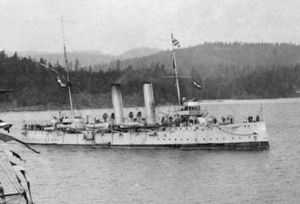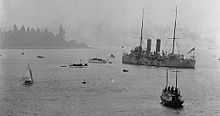HMCS Rainbow (1891)
 HMCS Rainbow in 1910 | |
| Career (United Kingdom) | |
|---|---|
| Name: | HMS Rainbow |
| Builder: | Palmers |
| Launched: | 25 March 1891 |
| Commissioned: | 1893 |
| Out of service: | 1909 |
| Struck: | 1909 |
| Fate: | Transferred to Canada |
| Career (Canada) | |
| Name: | HMCS Rainbow |
| Acquired: | 4 August 1910 |
| Decommissioned: | 1920 |
| Struck: | 1920 |
| Fate: | Scrapped |
| General characteristics | |
| Class & type: | Apollo-class protected cruiser |
| Displacement: | 3,600 tons |
| Length: | 314 ft (95.7 m) |
| Beam: | 43.5 ft (13.3 m) |
| Draught: | 17.5 ft (5.3 m) |
| Speed: | 19.75 knots (36.58 km/h) |
| Complement: | 273 to 300 (Officers and Men) |
| Armament: |
2 × QF 6-inch (152.4 mm) guns |
HMCS Rainbow, formerly HMS Rainbow, was an Apollo-class protected cruiser built for Britain's Royal Navy by Palmers at Hebburn-On-Tyne in England. She was launched on 25 March 1891 as HMS Rainbow and entered service in 1893. She was transferred to the Royal Canadian Navy in 1910 and scrapped in 1920.
Operational history
Royal Navy
She would serve in the China Station in Hong Kong from 1895 to 1898 and in Malta from 1898 to 1899. Rainbow had an operating cost that was deemed excessive and between 1900 and 1909, saw very little service. Most of her operations at this time were closer to England. On 17 December 1901 she was commissioned at Devonport by Captain D. Y Greet for service in the cruiser squadron as an additional ship in home waters.[2] During this time, she also saw a severe reduction in fleet support, resulting in only minor modernization. Her crew rotation at this time was used as a training cycle. Eventually, she was not used at sea at all from 1907 to 1909. In early 1909, the Admiralty ordered her decommissioned and placed on the inactive list.
Royal Canadian Navy
HMS Rainbow was presented to Canada in 1910, and was recommissioned HMCS Rainbow. In 1910, two old cruisers, Niobe and Rainbow were purchased from the Admiralty to be used as training ships at Royal Naval College of Canada in Halifax, Nova Scotia.[3] Classes at the Royal Naval College of Canada were held on Niobe, which was also used to train the cadets.[4] Damaged in the 1917 Halifax Explosion, Niobe was scrapped in the 1920s. Niobe and Rainbow were the first two ships of the Royal Canadian Navy that were purchased from the Admiralty. Rainbow entered Canadian service on 4 May 1910. Her initial duties included training, ceremonial visits and fishery patrols. She served Canada's Pacific Coast from Esquimalt, British Columbia.

In 1914, Rainbow was called to Vancouver to assist with an international incident that was unfolding. The Komagata Maru, a ship filled with Sikh immigrants from India, challenged Canada's immigration law, designed to prevent immigration from South Asia. The ship's passengers were not permitted to disembark even though they were British subjects. Rainbow was sent to force the ship to return to India. Twenty of the passengers were killed upon returning to Budge Budge, India, after they resisted an attempt to forcibly return them to Punjab.[5]
When World War I broke out, Rainbow was already underway on a mission to find and engage ships of the Imperial German Navy in the Pacific Ocean; in particular SMS Leipzig and SMS Nurnberg. She never met either of these ships, although she missed Leipzig by only a day at San Francisco.[6] This was to be Rainbow's first and only taste of peril.
In 1916 and early 1917, Rainbow was used to transport $140,000,000 in Russian gold bullion (valued in 1917 Canadian dollars), between Esquimalt and Vancouver.[7] This money was placed in trust with Canada by the Russian government for protection due to the impending Russian revolution.
The Royal Canadian Navy found that the cost of operating Rainbow was using up too much of the West Coast naval operations budget, and the crew of Rainbow were sorely needed on the Atlantic coast for the fight against the U-boats. Rainbow was decommissioned and de-activated on 8 May 1917, her crew sent east. One month later, she was recommissioned in Esquimalt as a depot ship. She served in this capacity until 1920, when she was sold for scrap.
Commanding officers
- Captain T. Y. Greet, RN 17 December 1901 -
- Commander J.D.D. Stewart (RN) 4 August 1910 - 23 June 1911
- CDR Walter Hose (RN then RCN) 24 June 1911 - 30 April 1917
- CDR H.E. Holme (RCN 1 May 1917 - 8 May 1917
- Lieutenant Commander J.H. Knight (RCN) 1 July 1917 - 21 August 1917
- CDR J.T. Shenton (RCN) 22 August 1917 - 12 May 1918
- Lieutenant Y. Birley (RCN) 13 May 1918 - 14 October 1919
- Captain E.H. Martin, CMG, (RCN) 15 October 1919 - 1 June 1920
Notes
- ↑ Admiral Percy Scott quotes 6 x 4.7 inch guns on sister ship HMS Scylla in 1899. "Fifty Years in the Royal Navy" published 1919, page 88
- ↑ "Naval & Military intelligence" The Times (London). Wednesday, 18 December 1901. (36641), p. 6.
- ↑ MacMillan-Murphy, Jim. "Esquimalt Remembers" Esquimalt Heritage Advisory Committee. Retrieved 20 July, 2013
- ↑ "Halifax Explosion: City in Shock - Devastation". CBC News. Retrieved 30 August 2013.
- ↑ Bruce Ricketts. "The Komagata Maru Incident". Mysteries of Canada. Retrieved 30 August 2013.
- ↑ Marc Milner (May/June 2004). "The Original Rainbow Warrior". Legion Magazine. Retrieved 3 December 2009.
- ↑ Clare Sugrue (2005-2006). "Ship histories: HMCS Rainbow". CFB Esquimalt Naval & Military Museum. Retrieved 3 May 2007.
References
- Macpherson, Keneth R. and Burgess, John. (1982)(Second Printing)The Ships of Canada's Naval Forces 1910-1981. Collins Publishers. ISBN 0-00-216856-1
| Wikimedia Commons has media related to HMS Rainbow (ship, 1893). |
| |||||||||||